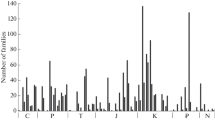Summary
It is impossible to study modern taxonomy without taking into consideration the population genetic and ecology.
Thé Linnean concept of monotypic species should be replaced by the biometric study of the frequency of the variability of the biological characters (particularly morphological) used in taxonomy.
The study of populations offers a larger scientific interest than the one of isolated types. It gives the possibility of caracterizing the evolution stability of the species.
So, Taxonomy can help considerably in biological control. By revealing large variability species, it gives a criterion of their adjusting plasticity.
But, by definition, the biological control is based on the adjusting capacity of the entomophagous insects either to a new host or to a new environment.
Information given by the taxonomist on the species stability has consequently a great value in the choice and use of the Entomophagous insects. — Ecologists using biological control, expect from the taxonomist to lie more than a label, which implies the use of biometric analysis methods in Entomophagous taxonomy.
Similar content being viewed by others
Bibliographie
Allen, H. W. — 1954. Propagation ofHorogenes molestae, an asiatic parasite of the oriental fruit moth, on the potato tuberworm. —J. ec. Ent.,47 (2), 278–281.
— — 1958. Evidence of adaptative races among oriental fruit moth parasites. —Proc. 10 Int. Cong. Ent.,4, 743–749.
Bocquet, C. — 1953. Recherches sur le polymorphisme naturel desJaera marina Fab. (Isopodes asellotes), essai de systématique évolutive. —Arch. Zool. Exp. et Gén. 90, 187–450.
Clausen, C. P. — 1942. The relation of taxonomy to biological control. —J. ec. Ent. 35, 744–748.
David, J. — 1953. Étude expérimentale des variations de l'aile vestigiale deDrosophila melanogaster Meigen. —Bull. Biol.,87, (4), 432–460.
Haeussler, G. D. — 1933. The oriental fruit moth,Grapholita molesta Busck, and its parasites in France and Italy. — 5thInt. Cong. Ent., 533–537.
Labeyrie, V. — 1959. Observations sur l'écologie de la Pyrale du Haricot (Etiella zinckenella Tr.). —Rev. Zool. agr., 1–6.
— — 1960. Influence de l'hôte sur la fécondité d'Acanthoscelides obtectus Say,C. R. Ac. Sc.,250, 615–617.
Labeyrie, V. — 1960. Contribution à l'étude de la dynamique des populations d'insectes: I. Influence stimulatrice de l'hôteAcrolepia assectella z. sur la multiplication d'un HyménoptèreIchneumonidae (Diadromus sp.). —Entomophaga, Mem. H. S. (1), 193 p.
Mayr, E. — 1946. The number of-species of birds. —Auk,63, 64–69.
Mayr, E., E. C. Linsley &R. L. Usinger — 1953. Methods and principles of systematic zoology. —McGraw Hill C ie, N. Y. & London.
Monchadskij, A. S. — 1958. A propos de la classification des facteurs du milieu. —Zool. Zh.,37 (5), 680–692.
Smit, B. — 1958. The changing habits of Insects,Sth. Afric. J. Sc.,54 (5), 107–110.
Author information
Authors and Affiliations
Rights and permissions
About this article
Cite this article
Labeyrie, V. Taxonomie, écologie et lutte biologique. Entomophaga 6, 125–131 (1961). https://doi.org/10.1007/BF02373217
Issue Date:
DOI: https://doi.org/10.1007/BF02373217




